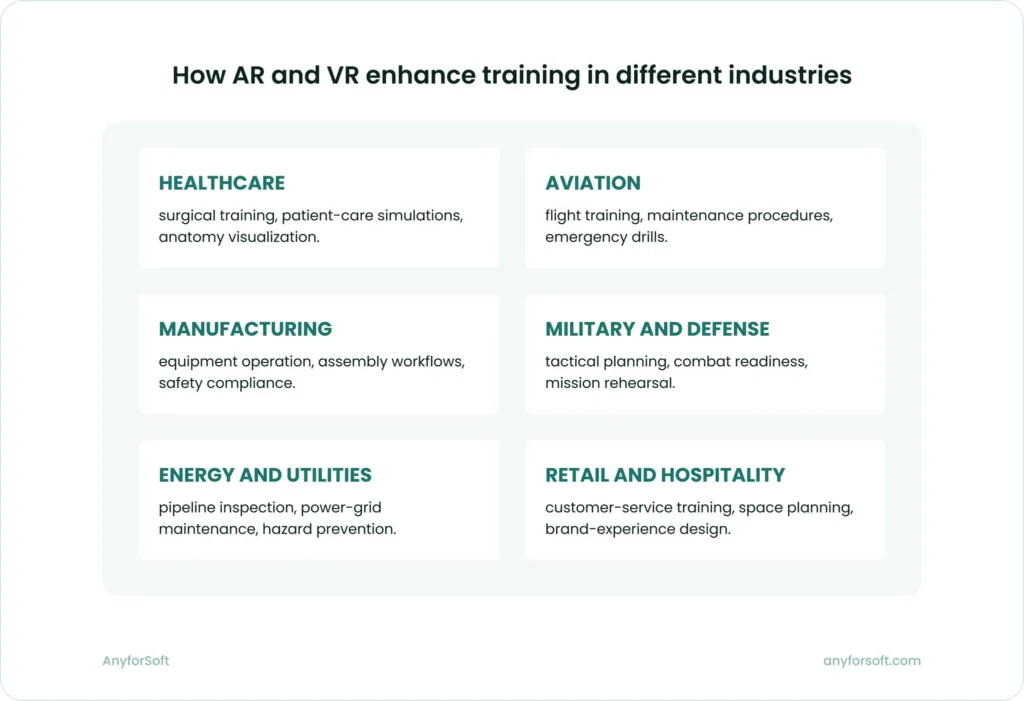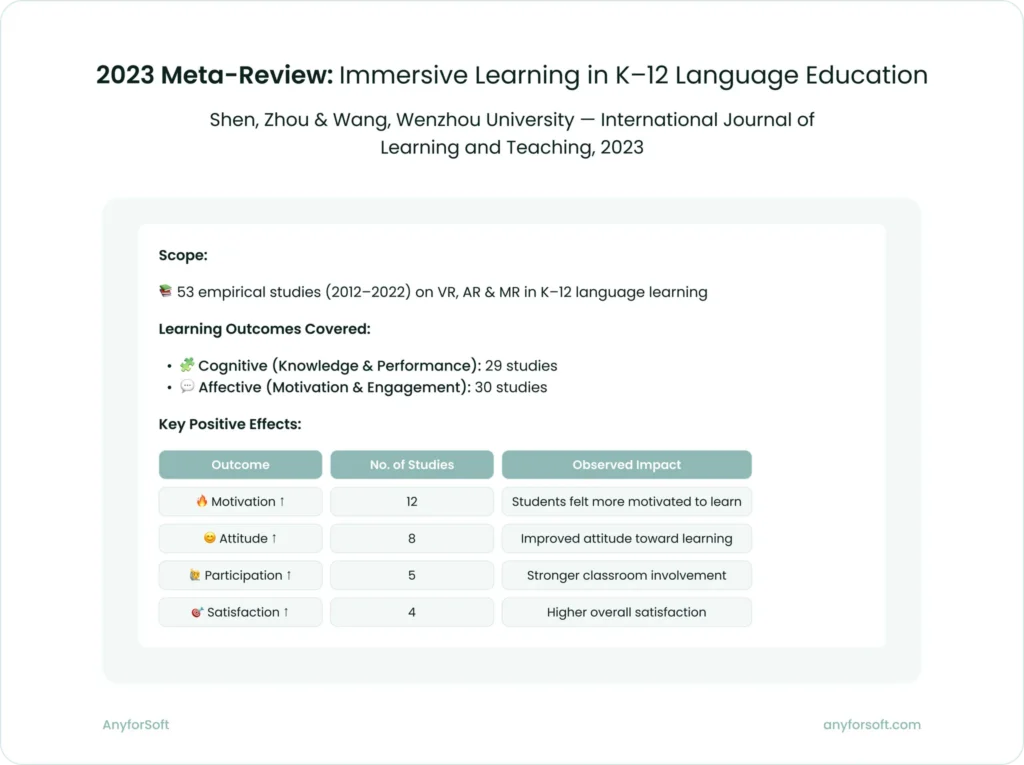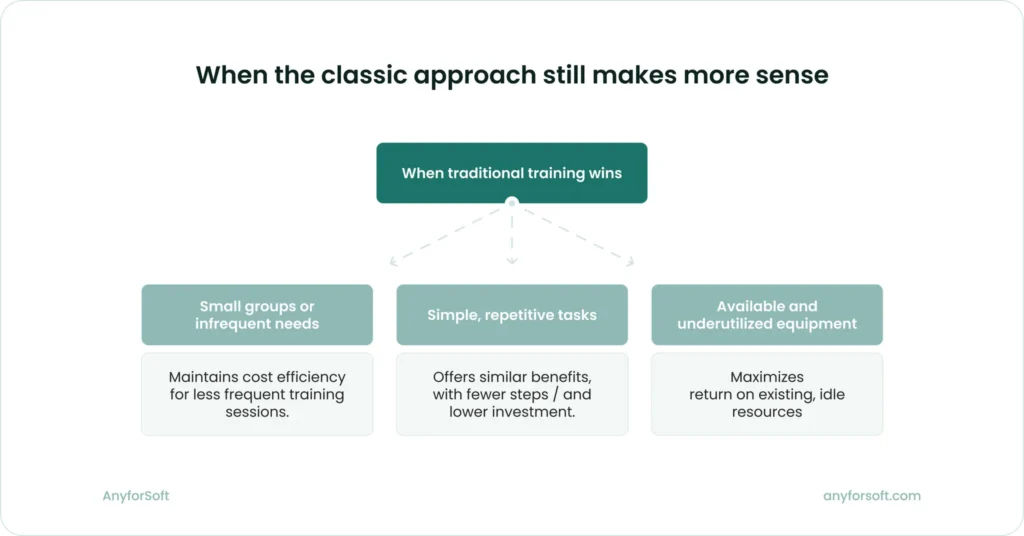By 2035, immersive technologies such as augmented, virtual, and mixed reality are projected to reach a global market value of 1.2 trillion dollars. What once seemed experimental is now becoming a standard component of workforce and institutional training. AR and VR are entering mainstream use as effective tools for building real-world competence in controlled, repeatable environments.
Education follows the same trajectory. The U.S. virtual reality education market is forecast to exceed 11 billion dollars by 2032, supported by innovations in adaptive testing and personalized learning. Enterprises are also driving adoption, representing more than 60% of global AR and VR training investments. Statistics confirms that immersive learning delivers value far beyond academic settings and highlights the potential of virtual and augmented reality in training programs.
This article is designed for decision-makers in business, government, and education who need more than a technology overview. It helps clarify:
- When immersive tools deliver measurable learning value
- How much they cost to implement and maintain
- Where simpler technologies can achieve comparable results
For over 14 years, AnyforSoft has helped organizations in education and enterprise training turn new concepts into practical software ecosystems through its E-learning software development services. Our goal here is to provide realistic guidance, grounded in experience, on whether AR and VR are suitable for your training strategy, your learners, and your budget.
The next section explains what these technologies actually are, covers the difference between AR and VR in e-learning, and explains what makes them effective for learning and skill development.
Understanding the Technologies
Both technologies aim to make learning more engaging, but they reach that goal in different ways — one adds to reality, the other replaces it entirely.
What AR and VR are and how they differ
Augmented reality (AR) adds digital elements to the real world. Learners see their surroundings come alive with 3D models, short hints, or small pieces of interactive data. What makes that possible? Usually a smartphone, a tablet, or an AR headset — familiar devices doing clever work behind the scenes, a practical augmented reality for e-learning pattern. The technology adds information without cutting people off from the world around them. In simple terms, it gives new meaning to the environment learners already know.
Virtual reality (VR) goes further. Instead of building on the physical world, it replaces it with one that exists only inside the headset. Learners enter simulated spaces where they can act, move, and test decisions safely. They perform tasks, handle virtual tools, and experience situations that would be expensive or risky in reality — core virtual reality in education and training use. Everything is designed to convince the senses that the virtual setting is real enough to learn from.
Imagine opening a portal to a parallel universe. Augmented reality is like standing at the threshold, looking through that portal and seeing explanations appear — what things are and how they work. Jump! You’re inside a new reality, the virtual one. It becomes a space where you can move, act, and learn as if the world around you had been rebuilt from the ground up.
The contrast becomes clear when we look at how it works in practice. Picture a maintenance technician preparing to service a complex machine. In AR, instructions and safety cues appear right on the real equipment, guiding each step while the person stays fully aware of the surroundings — typical augmented reality in training use. In VR, that same technician trains inside a virtual plant, free to experiment, make mistakes, and repeat each motion until it feels effortless — a pattern seen in virtual reality in training and development.
On the technical side, AR relies on computer vision to recognize surfaces and attach digital content to them. VR uses motion tracking, rendering engines, and spatial audio to create believable depth and presence. These differences affect not only the kind of hardware needed but also how complex and costly development becomes.
From a learner’s point of view, AR builds situational awareness, connecting knowledge to real context. VR strengthens muscle memory and procedural confidence through practice. Together they complete a learning circle that starts with understanding and ends with doing — one that helps people carry what they learn into the real world with confidence.
Where AR and VR excel: what they can do that other technologies can’t
Most digital learning tools are good at passing information along but rarely help people think and move like professionals, and AR and VR change that. They let learners step inside the process, test their reactions, and get a feel for the work itself. That small shift — from reading about a task to living it — often makes the difference between short-term recall and long-term skill.
Key benefits of AR and VR in education are their ability to build spatial awareness. In AR, a trainee can examine a digital twin of a turbine or a heart, walking around it and seeing every angle in real scale. That physical sense of proximity and size gives context no video can matchб echoing virtual reality in science and education results. For fields that depend on accuracy and timing — surgery, manufacturing, aviation — that awareness translates directly into safer, more precise action.
E-learning virtual reality takes the next step by training muscle memory. Learners can repeat a task hundreds of times without breaking anything or wasting materials. Each trial sharpens coordination until movements feel instinctive; that’s why virtual reality in online education often emphasizes hands-on scenarios. . In traditional training, that level of repetition would be too expensive or risky; in VR, it’s just part of the plan.
There’s also the question of presence, i.e., the mind’s ability to believe it’s really there, and that’s one of the advantages of virtual reality in education, especially when engagement matters most. A well-designed simulation can recreate tension, urgency, or teamwork in ways a slideshow never could. That emotional realism keeps people focused and turns abstract lessons into experiences they can actually remember.
Arizona State University is a bright example of AR and VR in e-learning at scale. Here, virtual reality has become part of introductory biology labs, where students explore cell structures and scientific processes as if they were inside them. Faculty describe it as a complete reimagining of how science is taught:
“There’s more curiosity and willingness to experiment with VR in classrooms now than we’ve ever seen before,” said a program lead at the university.
Isn’t it proof that VR’s value goes far beyond visual novelty?
When artificial intelligence joins the mix, immersion becomes adaptive. AI-driven tutors read learner behavior, such as eye movement, timing, hesitation, and respond on the spot. The system can slow down, explain again, or raise the challenge when someone is ready. Each mistake becomes a data point, each success a signal, creating a feedback loop that traditional classrooms can’t match. That’s how generative AI in virtual reality training works.
Combining these insights with a focus on how to implement AI responsibly helps organizations balance innovation with ethical use of learner data.

Real-World Examples of AR/VR in Training
What started as small pilots is now scaling across departments, bringing faster learning and more confident teams, which are hallmarks of augmented reality in training and education.
In corporate training
Over the last few years, immersive learning has quietly gone mainstream. Since 2020, companies have used AR and VR not just to innovate, but to fix real problems, such as slow onboarding, safety mistakes, and inconsistent customer service.
The pattern is the same across industries: shorter courses, better recall, and training that feels more like practice than study.
Take Walmart, for example. The retailer introduced VR E-learning training in all its U.S. stores, reaching more than one million associates. The data show 10–15% higher test scores among employees who trained in VR, and even observers — those who only watched sessions — kept more knowledge afterward. One course dropped from eight hours to just 15 minutes, saving time while boosting performance. The simulations cover both tech-related tasks and soft skills like customer service, helping employees feel prepared before stepping onto the floor.
According to Andy Trainor, Walmart’s senior director of U.S. Academies, the real strength of VR lies in its ability to make learning experiential — when employees complete a module through the headset, their brains register it as something they’ve actually lived through. That sense of “real” experience helps them remember procedures longer and react faster when facing real customers.
Bank of America took a similar route in a completely different industry. In 2021, it became the first major U.S. bank to roll out VR learning across 4,300 financial centers for about 50,000 employees. The goal was to help staff handle complex client interactions with confidence. After training, 97 percent of participants said they felt more comfortable doing their jobs. What makes the system stand out is its AI-driven role-play simulator. It listens, adapts, and adjusts the difficulty as learners speak. Managers then use the analytics to plan follow-up coaching, creating a training loop that feels both human and data-smart.
Verizon faced a problem that training manuals couldn’t solve. Store leaders knew the safety rules by heart, yet during real robberies, panic often took over. To fix that, the company turned to virtual reality — transforming real security footage into high-stakes simulations that felt uncomfortably real. One moment, the store was quiet; the next, a masked figure appeared, demanding cash.
As employees moved through the scenario, their heart rates and reactions were tracked, revealing how they managed stress when it mattered most. Afterwards, confidence levels soared, and recall of safety steps improved sharply. The pilot worked so well that Verizon expanded it to 1,600 stores and 22,000 employees. Now the company uses VR not only for emergency drills but also for empathy and customer-service training — proof that virtual reality in sales training can reinforce frontline behaviors.
Across these examples, one theme keeps coming up: immersive learning turns theory into action. It shortens the distance between training and real work, giving people room to try, fail, and try again without the pressure of real-world consequences. That’s what makes it stick.
In education
Across schools and universities, educators are finding that immersive virtual reality in education changes how students connect with complex ideas. When lessons turn into experiences, attention holds longer and comprehension deepens, even in subjects that once felt abstract or distant.
Morehouse College (USA) stands out as one of the first institutions to build a full “Metaversity,” a digital twin campus. About ten courses, from history to chemistry, now take place in virtual reality. Students join through headsets either on campus or remotely, learning side by side in shared 3D spaces. Here are the effects of virtual reality in learning: in a VR history class, attendance increased by 10%, and final grades rose compared with traditional instruction. In advanced chemistry, students said that walking around room-sized molecules helped them understand concepts that once seemed impossible to picture.
In K–12 education, immersive tools are reshaping how children grasp science and geography. A controlled study in China found that high schoolers who learned astrophysics through VR achieved a 90% pass rate. Compared with 40% for students in a standard classroom, the figure turns out to be a headline data point for virtual reality benefits in education.
Now, a short minute of scientific seriousness — and a quick stats drill for those who love evidence.

In high-risk and technical industries
Safety-critical sectors have become some of the fastest adopters of augmented reality in training and development. When mistakes can cost lives, companies turn to AR and VR to build skills that stick — and to test reactions in ways classroom theory never could.
Virtual reality in healthcare training has seen some of the most dramatic gains. A randomized study found that orthopedic trainees who practiced in VR performed procedures nearly three times more accurately than those trained traditionally — a success rate of about 75–78% versus 25%.
Hospitals and training institutes like Johnson & Johnson’s now use hundreds of headsets for joint-replacement courses, letting doctors learn new techniques anytime, anywhere. Many of these systems include AI-driven feedback, using computer vision to track hand movements and correct errors in real time.
Emergency response teams are also adopting VR to simulate dangerous situations safely. The East Meadow Fire Department in New York trains its 200 volunteers with VR headsets, running through 60 realistic fire scenarios that include heat vests and haptic hoses. What used to be a few live-burn drills per year can now happen any time, dramatically increasing practice frequency. Early reports show improved reaction times, better decision-making, and stronger recruitment among younger firefighters.
In aviation, the results are equally tangible. Since 2020, the U.S. Air Force’s Pilot Training Next program has been using VR cockpits combined with biometric sensors and AI to adapt lessons to each cadet’s pace. That’s the advanced form of virtual reality in pilot training. Graduates trained this way needed 10% fewer flight sorties while meeting the same standards.
The energy and industrial sectors are realizing equally high returns. Companies such as Shell and BP report 30–50% fewer training errors and significant safety gains after adopting AR/VR programs. Workers now rehearse hazardous tasks virtually — from blowout prevention to chemical leak response, without stepping into danger.
The success stories across healthcare, aviation, and energy prove that immersive training delivers clear value — yet every innovation brings a question few organizations can ignore: how much does it really cost to make this work? Understanding where the money goes is the next step toward deciding whether AR or VR training fits your strategy.
How Much Does it Cost? Comparing Virtual and Real-World Training
Understanding the cost of immersive training starts with a clear look at all the moving parts — from the headsets people use to the systems that keep them running. Budgets shift depending on project goals, simulation depth, and how broadly the program is deployed. Most of the expense appears upfront, while operating costs remain lower once content can be reused. A solid grasp of this structure is critical for understanding the cost of augmented and virtual reality in education over time.
The cost structure of AR/VR training solutions
Every immersive training initiative relies on a few main cost pillars. Together, they define how ambitious a project can be and how sustainable it will remain over time, being grounded in augmented and virtual reality in the education market context.
1. Hardware. This includes headsets, motion controllers, tracking systems, and computers that can render high-quality visuals without delay. Some setups expand further with AR glasses or haptic feedback devices that make the environment feel physical. Hardware selection often sets the tone for the entire system’s performance and budget range.
2. Software and content development. Building realistic simulations requires 3D modeling, programming, interface design, and quality assurance. When training needs to mirror real-world equipment or record learner performance, development time and costs grow. The more precise the simulation, the higher the investment — but also the greater the potential to reuse it across teams or departments.
3. Maintenance and support. Ongoing updates are common challenges of AR and VR. After launch, systems need security checks and user support. These activities keep training reliable and compliant with evolving internal procedures or hardware standards. Regular upkeep also ensures that new users can access content smoothly, without losing time to technical issues.
4. Cost per trainee and scalability. Once the foundation is built, costs begin to scale differently. Total expense depends on how many people train, how often sessions repeat, and how efficiently scheduling and access are managed. In well-run programs, the cost per person decreases with each reuse of existing content — a key driver of long-term efficiency.
Together, these components outline where the money goes and what drives cost variation in immersive training. They also prepare the ground for a direct comparison between virtual and traditional learning methods, showing how digital environments can reduce certain expenses while introducing new types of investment.
Real-world cost comparison: When virtual reality for training pays off
AR and VR training often seem expensive at first glance. But when you compare those costs with what it takes to deliver the same experience in real life — time, equipment wear, fuel, or safety precautions — the equation shifts. From this perspective, immersive training becomes an economic shortcut to real-world experience.
One of the clearest examples comes from pilot training, a field where precision and safety leave no room for compromise. To illustrate the cost-efficiency balance, we refer to two open data sources: the U.S. Air Force Pilot Training Next program (2019) and Leopard Aviation commercial pilot cost data (2025). While both document real-world training economics, they differ in scope, purpose, and timing. Hence, they are provided for conceptual understanding only. The comparison goal is to illustrate how virtual training reshapes cost structure, rather than to serve as a direct, one-to-one financial relation.
Pilot Training Cost Comparison
| Training Method | Average Cost | Time to Certification | Details |
| VR Training System | ~$1,000 per unit | ~4 months | Used in U.S. Air Force Pilot Training Next program; 13 pilots certified in 4 months using VR headsets with AI biometrics |
| Legacy Flight Simulator | ~$4.5 million per unit | ~12 months | Traditional multi-million-dollar simulators used before VR adoption |
| Full Flight Simulator (Type 7) | $12+ million (excluding operation) | N/A | Commercial airlines use for advanced and recurrent certification |
| Real Aircraft (Private Pilot License) | $8,000–$15,000 total | 50–70 flight hours typical | Includes aircraft rental ($165–$250/hr), instructor time, ground school, exams, and equipment |
| Real Aircraft – Hourly Training Rate | ~$259/hour (dual instruction) | N/A | Aircraft + instructor. FAA requires minimum 40 hours, though students often need 50–70 |
Key Efficiency Metrics
| Metric | Traditional Approach | VR-Based Approach | Improvement |
| Equipment Cost | $4.5M per simulator | $1,000 per VR system | 99.98% cost reduction |
| Training Duration | ~12 months | 4 months | 67% faster |
| Pilots Certified | Standard progression | 13 certified in one VR cohort | Demonstrated viability |
The following table outlines the typical cost progression in pilot training and shows where VR fits within the overall process. It illustrates how expenses increase with certification level and how immersive learning reduces costs in the earliest, most repetitive stages.
Cost Progression Overview
| Stage | Training Mode | Approx. Cost | Purpose |
| 1️⃣ Foundation | VR flight simulation | ~$1,000 (equipment) | Learn basic controls, navigation, procedures |
| 2️⃣ Initial Skills | Real aircraft (PPL) | $8,000–$15,000 | Obtain FAA certification and flight experience |
| 3️⃣ Advanced Training | Simulators + real aircraft | $8,000–$13,000 | Gain instrument and multi-engine ratings |
| 4️⃣ Professional Level | Commercial pilot license | $30,000–$50,000 | Accumulate 250 flight hours and professional proficiency |
| 5️⃣ Airline Qualification | Type-specific simulator + real aircraft | $70,000–$130,000 | Final step toward Airline Transport Pilot License |
The comparison makes the economic advantage clear even if the data sets aren’t fully synchronized. A VR system that costs about $1,000 per unit replaces a large portion of the initial learning curve previously covered on $4.5 million simulators or real aircraft costing $259 per flight hour. The U.S. Air Force’s Pilot Training Next program also demonstrated that certification time could drop from a year to roughly four months.
Virtual flight simulation can’t replicate real-world flying conditions entirely, yet it fills a crucial gap between theory and practice. Students who begin their training in VR develop core procedures, spatial awareness, and confidence before entering high-cost simulators or aircraft. That shift shortens training duration, reduces expenses, and makes aviation careers more accessible — demonstrating corporate training in virtual reality principles applied to pilot pipelines.
When the Math Doesn’t Work: Scenarios Where Traditional Training Wins
Immersive technologies offer measurable ROI in large-scale or complex programs, but they are not the answer to every training challenge. In smaller, simpler, or already well-equipped contexts, conventional tools remain the smarter financial and operational choice.
The following cases provide a practical view of the advantages and disadvantages of virtual reality in education in context.
Low-volume training needs
When training sessions are rare or involve very few participants, the cost of building immersive content rarely pays off. The expense of headset procurement, simulation design, and ongoing support spreads across too few users — a good complement to augmented reality in training alternatives.
Traditional training wins here because it scales down easily — you can train a small group without any upfront development. Common options include instructor-led workshops, recorded video tutorials, and lightweight e-learning modules hosted in an LMS.
Use case:
A regional construction firm needs to certify ten supervisors annually in safety compliance. A one-day in-person course led by an internal trainer costs less than designing a VR simulation that might only be used once or twice a year.
Efficiency comparison for small-scale training
| Factor | Traditional Method | Immersive Method |
| Development cost | Minimal (trainer + materials) | High (custom module) |
| Reuse potential | Limited but cheap | Low reuse, expensive |
| Best suited for | Small teams, rare sessions | Large, recurring programs |
Simple procedures
Some learning objectives are straightforward enough that realism adds no real benefit. When tasks involve linear actions — for example, completing digital forms or following standard operating steps — virtual environments risk overengineering the solution. In other words, pure e-learning augmented reality isn’t required here.
Traditional methods prevail through clarity and speed. Screen recordings, interactive PDFs, or microlearning quizzes communicate the same information effectively with minimal setup.
Use case:
An administrative department introduces a new HR system. Employees learn to update their profiles via a short step-by-step video and interactive quiz rather than navigating a simulated VR office.
Comparative efficiency for linear tasks
| Factor | Traditional Method | Immersive Method |
| Setup time | Hours or days | Weeks or months |
| Learning value | Sufficient for simple tasks | Adds unnecessary complexity |
| Cost efficiency | High | Low |
Available real equipment
When training involves equipment that’s already on-site and safe to use, virtual duplication adds unnecessary cost. Real tools provide direct sensory feedback that digital replicas still struggle to match.
Traditional training benefits from this accessibility. Job-shadowing, on-the-job mentoring, or supervised practice sessions allow learners to engage with the real environment without major investment. That’s a more reasonable approach than to force a virtual reality in a business training.
Use case:
A manufacturing plant uses idle production machines during maintenance hours to train new operators. The setup costs nothing extra, and trainees gain realistic experience under supervision.
Cost–benefit balance when real tools are accessible
| Factor | Traditional Method | Immersive Method |
| Equipment use | Real machines, real context | Digital twin creation |
| Feedback quality | Authentic tactile response | Simulated approximation |
| Upfront cost | None | Moderate to high |
Limited reuse or high setup costs
AR and VR systems rely on specialized devices, software maintenance, and periodic updates. When a course covers a one-time or short-term topic, these overheads can exceed any learning benefit, diminishing the positive outcomes of augmented reality in corporate training.
Traditional tools hold the advantage through flexibility. Instructor-led sessions, webinars, or blended formats can be launched quickly, updated easily, and retired once the project ends.
Use case:
An energy company runs a three-month onboarding program for a temporary field project. Webinars and short video guides prepare contractors efficiently, avoiding the need for a full immersive module.
Efficiency comparison for short-term or one-time training
| Factor | Traditional Method | Immersive Method |
| Lifespan of content | Short, disposable | Long-term investment |
| Maintenance needs | Minimal | Continuous |
| Return on investment | Immediate | Unlikely |
Recognizing these contexts prevents unnecessary spending and helps organizations apply immersive learning only where it brings real strategic value. The next section translates all these insights into a decision-making checklist to help evaluate when AR or VR training is worth the investment — and when traditional methods remain the better fit.

Conclusion
We hope this piece helped you see immersive learning in perspective — its potential, its limits, and the many ways it reshapes professional training. For some organizations, AR and VR are already part of everyday practice. For others, they remain an opportunity waiting for the right moment.
The real value lies in clarity: knowing which technologies move your learning goals forward and which approaches keep things efficient and human. Sometimes innovation looks like a headset; other times, it’s simply using familiar tools in smarter, more engaging ways — an approach that still fits augmented and virtual reality in education as it matures.
At AnyforSoft, we’ve spent more than a decade helping organizations make those choices with confidence — building e-learning ecosystems that balance creativity, technology, and measurable results.
When the time comes to explore how augmented and virtual reality can be used in training in your organization, we’ll be here to help you take the next step.
FAQs
Costs stretch across a wide range, depending on what you’re building. A basic 360° walkthrough or off-the-shelf VR module might run $15,000–$30,000, while a fully custom simulation—say, one that tracks movement or gives AI feedback—can climb well past $100,000. Hardware is the easy part: enterprise headsets usually cost $700–$2,500 each. The real expense lives in the content, not the goggles.
Partnering with an experienced E-learning app development company ensures th investments align with both your learning goals and long-term scalability.
They can, though it’s usually wiser to start small: a pilot with one reusable scenario helps validate virtual reality in training without overspending. Many smaller teams begin with one reusable pilot scenario and expand only if the results prove measurable. Renting equipment or partnering with a vendor that offers shared content libraries keeps budgets under control. For most small organizations, the goal is to test usefulness first, scale later. Moreover, smaller institutions often achieve better cost efficiency by working with an education software development company to modernize existing systems instead of adopting complex immersive setups.
It depends on how real you want “realistic” to be. A simple AR overlay or short VR scene might be ready in four to six weeks, while complex, interactive environments often take three to five months. Much of that time goes into scripting and design rather than coding—the storytelling part of training takes more thought than people expect. In sum, light simulations take weeks, while advanced builds take months in virtual reality in training and development.
Surprisingly few. You don’t need a lab full of engineers, rather the right mix of people. Usually it includes:
- An IT or LMS manager to handle integrations.
- A trainer or content lead to keep materials accurate.
- A technical partner for updates and support.
Today’s cloud-based deployments mean you can run the whole thing remotely without hiring a dedicated in-house team.
To sum up, most teams rely on vendor support plus an LMS owner for augmented reality in training content updates.
Some teams also integrate AI chatbots in E-learning to automate routine support, provide instant answers, and guide users through immersive content.
Hands-on practice often boosts retention in virtual reality benefits in education. Studies show it can push knowledge retention up to 75%, compared to about 10–20% for passive formats. Learners remember because they do things, not just read about them. That said, traditional methods update faster and cost less, which is perfect for compliance or policy refreshers. The sweet spot is using both: immersive for performance, traditional for pace.
Jumping in for the “wow” factor. Skipping needs analysis leads to underused modules in augmented reality in corporate training initiatives. Another misstep: ignoring updates. Procedures change, and virtual environments need to keep up. The best programs treat AR and VR as part of a long-term learning ecosystem, not a one-off experiment that looks good on launch day.








